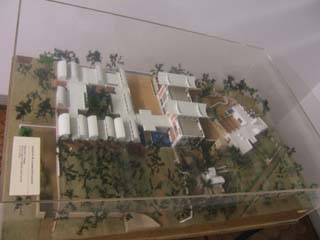
|
A scale model of the five hectare site of the Maeght
Foundation in St. Paul de Vence. Note the famous U-shaped roofs
of the main building. You enter from the parking lot which is at
the lower left. The Maeght Foundation has solved the copyright
issue over their works by simply charging a small fee (2.5 euros) for
the privilege to take photos. Hence I have them to share.
|

|
"Femme" (woman) by
Miro. Miro's symbolism reduced to its most blatant greets
the visitor just inside the front gate to the foundation which leads
into the sculpture garden.
Oddly, there were more sculptures by Miro than any other artist at the
Maeght Foundation. Most had been expanded to monumental scale
(this
piece is ten feet tall).
|
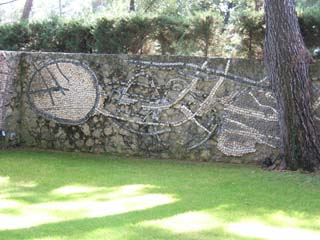
|
Much more enigmatic is
the mosaic by Pierre Tal Coat, inset into the stone wall of the
sculpture garden. It was completed during 1963-64 and has aged to
the natural gray of all of the lichen covered rock
around here. In another fifty years it will be nearly
invisible. I kind of like that.
|

|
The initial source of Aime and Margarite Maeght's
passion to establish the Maeght Foundation and museum was the death
of their youngest son Bernard. It is not surprising then that
this contemporary art museum should also contain a chapel. It is
built in true European fashion out of bits of ancient artifacts
juxtaposed in a modern structure with works by ancient and modern
artists.
These carved slates (by Raoul Ubac) are abstractions whose meanings
seem clearly to relate to the illustrations that depict the story of
Christ even though the titles were written in French. When I
found them later in English it only confirmed that they were what you
might expect for a chapel. It was nice though to see them as
designs first and illustrations second. Other works include a
stained glass window by Georges Braque and a 15th century Spanish
Crucifixion. The chapel was built on the site of an ancient
sanctuary to...St. Bernard.
|
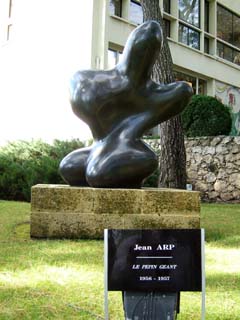
|
"Le Pepin Geant" was
the only piece I saw by Jean Arp. I am a big fan of Arp and see
his influence everywhere from Barbara Hepworth and Henry More on
forward. This is one aspect of the history of art that I
understand.
|
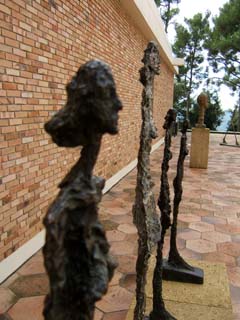 |
The courtyard on the
opposite side of the Museum was my next destination. It is
entirely dedicated to works by Alberto Giacometti who, like Miro,
Braque
and many of the other main artists, had a direct hand in the design and
construction of the foundation museum. The Maeghts were gallery
owners who befriended a
number of the artists that either were already or became what we now
think of as the big names of European art of the twentieth
century. The museum is as much as monument to the artists as it
is for the Maeghts. This is fitting because they all worked
together to build each other's fortunes and reputations. At left,
Giacometti's standing
women, his brother and walking man. For some reason, women stand
and men walk for Giacometti.
|

|
On the north side of
the complex is a whole garden dedicated to Miro. I think of Miro
as a primarily a painter and the work of his friend Calder as capturing
the surrealist nature of Miro's paintings but Miro also did a number of
sculptural works and seems to have dedicated a considerable amount
of his resources and last years to setting up this sculpture
garden. In the
foreground is "solarbird" and in back is the "lunarbird" each is done
in marble (eight to ten feet tall) following an early carving in wood
(a few inches). He chose to keep his early moves, such as the
sketchy line around the eye, as they were in the early model rather
than change it to meet the larger scale. It works. Its too
bad that there wasn't a separate fee for touching the works because
these in particular looked like they were made to be enjoyed tactiley.
|

|
If I was surprised to
see so many sculptures by Miro, I was even more surprised to see so
many paintings by Calder. The interior of the museum building
itself contains a
number of gallery rooms that contain primarily paintings. I was
already overloaded with thoughts and images by this time so it was hard
to appreciate. It is times like this that I realize that I am a
sculptor because, given my limited mental energy at the time, I
could not force myself to contemplate two-dimensional works unless they
had some use for me in higher dimensions.
|

|
It must be the similar
for others because the few sculptures by Braque were really just
orthogonal presentations of 2-d works. But I guess I should
expect that from the cofounder of cubism who pioneered the presentation
of multiple projections of an object into one two-dimensional image.
|
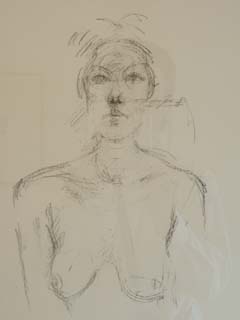
|
Giacometti, on the
other hand, impressed me with his drawings which are better than his
sculpture! This image of a woman "Buste II" is not titled
correctly because it is the way he draws the eyes that drew me into
this image. He has a command of anatomy which does not show in
his abstracted sculpture that is so much about texture. I've read
comments by Giacometti where he talked about getting fixated on one
aspect of the figure (typically the feet). The strokes in this
drawing record this fixation which begins at the eyes and works outward.
|
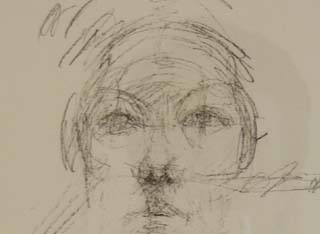
|
So despite being inclined to
disregard 2-d work I found this drawing to be the lasting image for me
out of the whole collection. |










